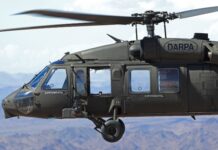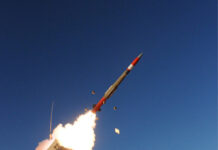In a one-on-one interview with ESD at the Farnborough International Airshow on 22 July 2024, Stephanie C Hill, president of Rotary and Mission Systems (RMS) for Lockheed Martin, highlighted some of the business’ main current integration and modernisation efforts.
A key area of focus among these is integration of the Patriot Advanced Capability 3 Missile Segment Enhancement (PAC-3 MSE) air defence missile with the Aegis Weapon System (AWS).
“PAC-3 MSE has been for a very long time an unmatched, combat-proven capability against advanced highly manoeuvrable threats like tactical ballistic missiles, cruise missile and aircraft,” said Hill, “and what we decided to do as part of our 21st century security vision a number of years ago was to invest in the integration of that great capability, that the US Army and other armies around the world use, with the Aegis Weapon System, which is the pre-eminent weapon system for surface navies, in the US and around the world.”
Hill revealed that the company has recently conducted a successful test of that integration work, putting the Patriot missile on a path to joining the array of weapons handled by the overall AWS.
“There’s still additional integration work that has to be done for it to be fully integrated and go through all the qualification testing that the system will need to go through,” Hill noted, “but the reality for PAC-3 MSE to be a surface navy-launched weapon was proven. That’s really fantastic because what that does is bring an integrated air and missile defense capability to the navy for shipboard action for the US and two allies around the world that have the PAC-3 and Aegis Weapon System.
One of the reasons we were able to do that as successfully as we were is because of the transformation of our Aegis Weapon System We’ve had the Aegis Weapon System for more than 50 years … but it has gone under significant transformation, it is completely modernised and will be continued to be modernised through what we call model-based engineering. And we’re developing software using very advanced software techniques that have allowed us to go from delivering capability where it used to take a year or more to delivering it in months, and days, and actually even hours. It’s a completely transformed way of delivering software capability and we’ve been able to demonstrate that in partnership with the US Navy.”
Hill pointed out that a recent example of this ‘speed to capability’, as Lockheed Martin puts it, was demonstrated in the autumn of last year after the company received data back from US Navy Aegis-quipped warships operating in the Red Sea to counter the threat there posed by hostile missiles and unmanned aerial vehicles launched by the Yemen-based Houthi militia. “In partnership with the navy we actually got data back and [decided] we needed to refine our artificial intelligence algorithms to be able to better differentiate and discriminate and identify the threats in the right way,” she explained, “and in 10 hours we delivered what we call over-the-air updates to the ship in theatre, and it improved the discrimination capability of the radar significantly – and I mean very significantly.”
Hill then went on to detail Lockheed Martin’s efforts in relation to the modernisation of the Black Hawk medium-lift helicopter. A key aspect of Black Hawk modernisation is the adoption of the GE Aerospace T901 powerplant, which the US government selected under the Improved Turbine Engine Program (ITEP) in February 2019. On 27 June 2024 an initial two T901 ITEs arrived at Lockheed Martin’s Sikorsky business in West Palm Beach, Florida. However, as Hill pointed out, Lockheed Martin has already been using its Raider X prototype for the now-cancelled Future Attack Reconnaissance Aircraft programme to conduct risk-reduction work in relation T901 integration on the Black Hawk.
Beyond adoption of the T901, Hill noted adoption of the US Army’s Modular Open Systems Architecture (MOSA) approach for the Black Hawk, which gives the aircraft a digital backbone and is a key enabler of new capabilities as well as the integration of manned/unmanned teaming.
“We are modifying the aircraft cabin to be able to accommodate these networked-drones that will be able to go out and get vital intelligence in contested environments and bring it back and ultimately enable the modernised Black Hawk to be an effective node in joint all-domain operations,” Hill said. “If you can connect different equipment, from different domains, different services, and then you look at this thing that’s called coalition joint all-domain command and control to connect it to even different countries, you have a force-multiplying effect against the threats that are facing you. And we’ve been able to demonstrate what’s in the realm of the possible for a modernised Black Hawk,” Hill added.

Lastly, Hill focused on Australia’s Project Air 6500 Joint Air Battle Management System (JABMS) programme, for which Lockheed Martin was selected in August 2023, with Hill noting that this was not just to fulfil the contract, but to act as a true strategic partner.
“They were looking not just at the capability that we had, but they were looking at how we behaved. They wanted to make sure that we were going to deliver what was best for their mission, versus what was best for their mission as long as it came from our company, so they were looking for us to bring in and develop an ecosystem of companies, large and small/medium enterprises, in that process.”
Vital to this programme, Hill noted, was to have a truly open systems architecture. “One of the greatest compliments we got,” she said, “was when a small business came in and they said, ‘We came in and we weren’t sure of how we were going to connect with Lockheed Martin’s system’, and they came in on a Thursday to integrate it on that Friday it was integrated. This is the future of how systems are developed and integrated; that’s when you know you have a real open architecture, when a small company not necessarily used to doing business with some of the larger military systems can come in and literally plug [its system] in and it works, so that’s what this Joint Air Battle Management System is about.”
Lockheed Martin’s current work on Air 6500 is on the first phase of the programme, which covers sensor and shooter integration and the establishment of the network. The next part of the programme, Hill explained, will be “when we’ll see some of the effectors that will come into play, and then the next phase will be around defence against high-speed threats”.
Hill suggested that, along with achieving its purpose of strengthening Australia’s ability to defend against threats in the Indo-Pacific region, Project Air 6500 could also serve as a procurement template for other nations looking to achieve the same kind of capability.
“As I have gone around to talk to different customers around the world who are very interested in what some call multi-domain operations and some call joint all-domain operations, many were waiting to see what Australia would do, so I really believe that the example that Australia is setting with this truly joint model – and they were able to acquire it jointly – will be a pathfinder for other countries. I’m not saying it would be the same solution, but it would be a pathfinder for what’s in the realm of the possible, how quickly you can do it, and the approach that you want to take,” she concluded.





![Hypersonic weapon interceptor developments The US MDA plans to conduct Flight Test Aegis Weapon System-43 (FTM-43) with the goal of using an upgraded Standard Missile-6 (SM-6) to physically intercept an HTV-1 hypersonic target. [MDA]](https://euro-sd.com/wp-content/uploads/2025/09/SM-6-_-8314132-Kopie-218x150.jpg)






